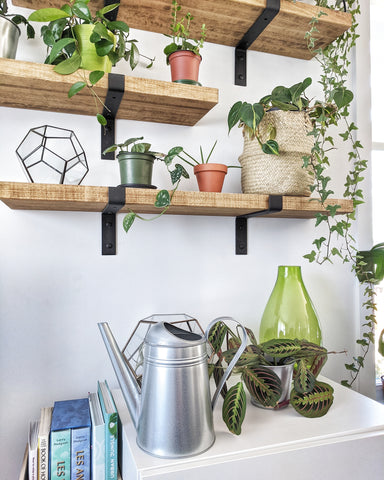How To Get Rid Of Fungus Gnats In Houseplants Soil
If you noticed a sudden influx of tiny fruit flies flying or crawling around the soil of plants, especially after watering, you probably have house plant gnats. Fungus gnats are attracted to moist soil and can breed and spread fast. The larvae feeds on organic matter and in severe cases, can feed on the roots of plants. They're also highly annoying.
Further down in this blog, we will list how to get rid of gnats on plants and the best methods to prevent fungus gnats.

Monstera leaves
Photo by Jeremy Lee on Unsplash
What are fungus gnats?
Fungus gnats are like tiny mosquitoes part of the Bradysia species. They're identified by their small bodies (smaller than regular fruit flies and thrips), gray or clear wings and have antennas. Fungus gnats lay eggs in organic matter, like soil. The adults can lay up to 200 eggs in the first inch of soil. In about 3-4 weeks, those fungus gnat eggs will hatch and start feasting on fungi or decaying plant matter and sometimes even the roots of the plants. Adult fungus gnats don't feed and can't bite, they're typically weak fliers and only live 7-10 days.

Prayer plant "Lemon Lime"
Photo by Madison Inouye
Fungus gnat infestation usually happen in the transition from winter to spring and from summer to fall. In the summer to fall period, adult fungus gnats can colonize in the soil of any houseplant that has been left outside during the growing season. When these houseplants are brought back inside, population will drastically increase due to the warmer temperatures in houses.
What Causes Gnats in Houseplants?
As mentioned earlier, fungus gnats can come from potted plants that have been left outside. They can also come from bagged potting soil or just consistently damp soil. Adult gnats need warm, moist soil in order to lay eggs and for the fungus gnat larvae to thrive. The first step you want to take to get rid of gnats is to back off on watering and give the soil more time to dry out.
How To Get Rid Of Gnats in Plants Naturally
Let the soil dry and repot
One way of preventing gnats in houseplants and one tip I don't see recommended enough, is to repot your houseplant, especially a newly purchased plant. Plants found in big box stores are often potted in heavily dense potting soil, the perfect breeding ground for fungus gnat larvae. Using a well draining chunky soil mix can do wonders for your plants.

Satin pothos on Cactrella trellis from Treleaf
Next, you need to buy a bag of nice quality fresh soil. I've notice a number of mainstream potting soil bags already infested with gnats and thrips.
Repotting that plant is one of the most effective ways of ridding fungus gnats. This eradicates all the larval stage.

Plants being repotted
Photo by vadim kaipov on Unsplash
Hydrogen peroxide
Mix equal parts of water and hydrogen peroxide. Use this solution for your next watering session. The hydrogen peroxide will target the larvae but not injure your plant. Hydrogen peroxide will also help with any root rot. The fungus gnat larvae will usually be gone in 1-2 waterings. Make sure to follow up with fertilizer. While hydrogen peroxide is great for targeting gnats it will also target any good bacteria as well.
Create a DIY gnat trap using vinegar
You can create your own DIY gnat trap by pouring equal parts of apple cider vinegar and water into a bowl. Leave the solution next to your plant. The adult gnats will be attracted to the scent, try to drink it and drown.
Use yellow houseplant sticky stakes
Yellow sticky traps are great for capturing adult fungus gnats and also help you gage which plants are the most infested. Put the sticky fly traps next to the soil of any indoor plants, they'll be attracted to the bright colors, fly into them and get stuck. This helps control the adult gnats so they don't lay eggs.
When the yellow sticky trap is filled, just toss it and replace it. This is best non toxic method for adult fungus gnats.
Bottom watering your plants
Instead of normally top watering you beloved plants, try to bottom water them. Put your plant in a tub or bathtub already filled with water. They'll slowly start to absorb water through the drainage holes. Pull plant out before the entire soil is saturated.
This can help keeping the top half of the soil surface dry. And the fungal larval can't grow in dry soil.
Beneficial insects
Beneficial insects are a great, non toxic way of treating any sort of houseplant pest. For fungus gnats, beneficial nematodes work wonders.

Plant corner
Photo by Véronique Trudel on Unsplash
Nematodes are a microscopic organism that seek out and kill fungus gnat larvae that live in the soil. Nematodes need to be watered in so be sure to follow the instructions on the package. But, nematodes is and effective and easy way of ridding fungus gnats.
Mosquito Bits
Mosquito bits are sold as granules. The active ingredient in mosquito bits is a biological larvacide called BTI (Bacillus thuringiensis subspecies israelensis). You can water your plants with a mosquito bit seeped water or just place some mosquito bits on the soil after watering. This should take care of the larval stage gnats in the soil.
More plant related blogs:
Best potting soil for houseplants
Not so common houseplants that make great houseplants
Should you cut dying leaves off your houseplants?
